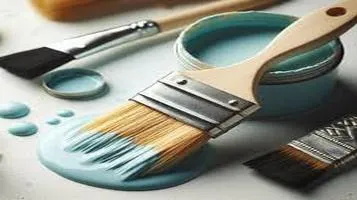Chalk Paint: A Versatile and User-Friendly Option for DIY Enthusiasts
Chalk paint is a versatile, decorative paint known for its matte, chalky finish, making it a popular choice for furniture and home decor projects. Developed by Annie Sloan in 1990, this paint is renowned for its ability to adhere to a wide variety of surfaces without the need for extensive preparation such as sanding or priming. It is available in an array of colors and can be easily mixed to create custom shades. Chalk paint is appreciated for its ease of use, requiring minimal brush strokes, which results in a smooth, vintage appearance. It can be distressed to achieve a shabby chic look or sealed with wax or lacquer for durability. Non-toxic and water-based, it is an ideal option for DIY enthusiasts seeking to transform their space with minimal effort.

In recent years, chalk paint has become a popular choice for both amateur and professional decorators. With its versatile application, ease of use, and distinctive matte finish, it has revolutionized the world of home decor and furniture restoration. As someone who enjoys DIY projects, I have had numerous opportunities to use chalk paint and can attest to its many benefits as well as some of its limitations.
What is Chalk Paint?
Chalk paint, not to be confused with chalkboard paint, is a type of paint known for its matte finish and velvety texture. It was popularized by Annie Sloan in 1990 and has since become a staple in the DIY and craft communities. The paint is water-based, making it easy to clean up with soap and water, and it adheres to a variety of surfaces without the need for extensive prep work.
Ease of Use
One of the most appealing aspects of chalk paint is its ease of use. Unlike traditional paints that often require sanding and priming, chalk paint can be applied directly to most surfaces, including wood, metal, glass, and even fabric. This makes it an excellent option for quick makeovers and spontaneous projects.
The paint dries relatively quickly, usually within 30 minutes to an hour, depending on the thickness of the coat and the ambient conditions. This allows for multiple layers to be applied in a single day, making it possible to complete projects in a shorter time frame.
Versatility
Chalk paint's versatility is another reason for its popularity. It can be used to create a variety of looks, from shabby chic to modern minimalist. With the right techniques, you can achieve a distressed finish, a smooth modern look, or even intricate designs using stencils and masking tape.
One of my favorite projects involved transforming an old, worn-out dresser into a statement piece for my bedroom. With just a few coats of chalk paint and some light distressing, the dresser went from drab to fab, adding a touch of vintage charm to the room.
Finish and Texture
The matte finish of chalk paint is one of its most distinctive features. It gives furniture and decor items a soft, chalky appearance that is both elegant and understated. This finish is particularly well-suited for rustic and vintage-inspired designs.
While the matte finish is beautiful, it is also somewhat delicate. Chalk paint can be prone to chipping and scratching, especially on high-traffic items like kitchen cabinets or frequently used furniture. To mitigate this, a protective topcoat, such as wax or a clear polyurethane, is often recommended. Waxing the painted surface not only enhances its durability but also deepens the color and adds a subtle sheen.
Color Range
Chalk paint is available in a wide range of colors, from soft pastels to bold, vibrant hues. Many brands offer pre-mixed colors, but you can also create custom shades by mixing different colors together. The paint's opacity ensures good coverage, even with lighter colors, making it easy to achieve the desired look without multiple coats.
Environmental Impact
As a water-based product, chalk paint is generally considered to be more environmentally friendly than oil-based paints. It has low levels of volatile organic compounds (VOCs), making it a safer option for indoor use. However, it is still important to work in a well-ventilated area and take appropriate safety precautions.
Limitations
Despite its many advantages, chalk paint is not without its limitations. As mentioned earlier, the matte finish is prone to chipping and scratching, which can be a drawback for high-use items. Additionally, while the lack of prep work is a major selling point, there are times when sanding or priming may still be necessary, particularly when dealing with surfaces that are very slick or have an existing glossy finish.
Another consideration is the cost. Chalk paint is often more expensive than traditional latex or acrylic paints. While the ease of use and versatility can justify the higher price for many, it may not be the best option for large-scale projects on a tight budget.
Conclusion
Overall, chalk paint is a fantastic option for DIY enthusiasts and professional decorators alike. Its ease of use, versatility, and distinctive finish make it a valuable tool for a wide range of projects. While it does have some limitations, the benefits far outweigh the drawbacks for most applications. Whether you're looking to breathe new life into an old piece of furniture or add a unique touch to your home decor, chalk paint is a reliable and stylish choice that is well worth considering.






